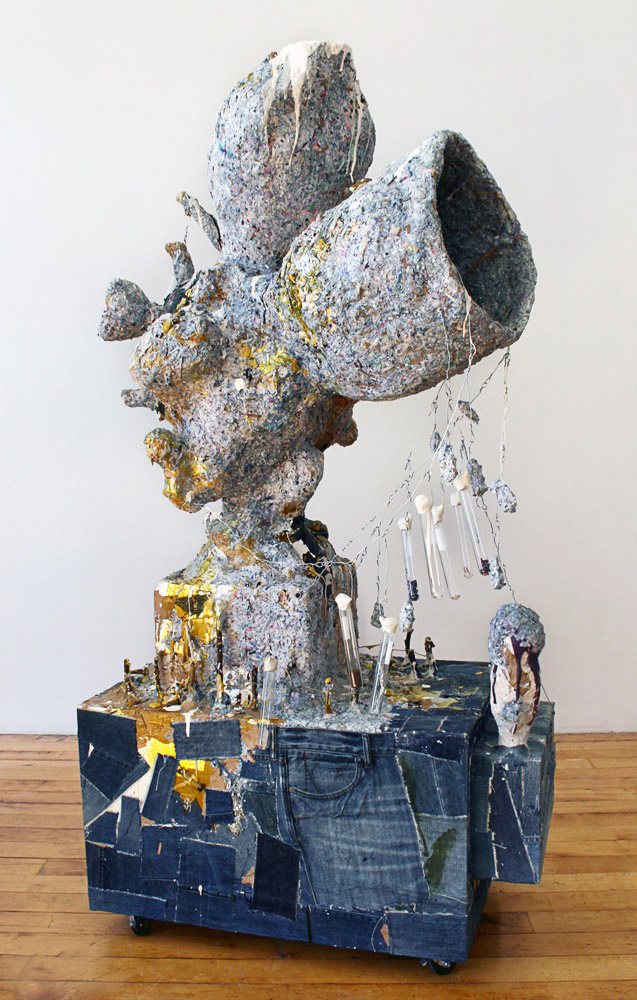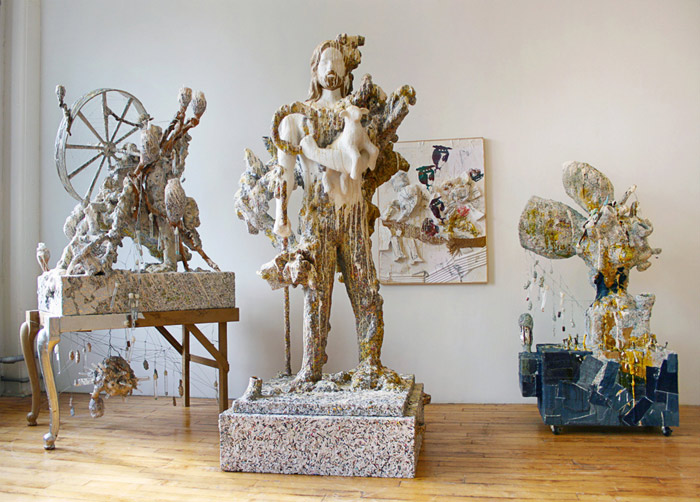Kris Scheifele: To call you a multimedia artist is an understatement. Online photos don’t do justice to how intentionally dense your work is, not only in the breadth and depth of your materials and techniques, but also in the way your practice is a kind of cannibalized familial gene pool. For instance, your paintings have been based on your sculptures, debris from paintings end up in collages. There’s a crafty resourcefulness and near fetishistic attention to detail combined with incredible technical prowess. Tell me a little about the inspiration for such a rich process.
Randy Wray: Well, I’m somewhat of a hoarder when it comes to my art. With each new body of work, I tend to introduce an idea, material, or technique into the mix, but I rarely discard anything completely or permanently. Things from the past eventually resurface. Experimentation is a big part of my process and I often work with what’s readily available. When I was just out of school and living in an old barn in Ogunquit, Maine, I had no money for art supplies. So during the day I gathered materials from nature—sea urchin and lobster shells, sticks, feathers, and rocks—and at night I joined them together to form small sculptures. More recently, I’ve fashioned works out of shredded junk mail, my old jeans and sneakers, and discarded furniture. I try to work with the ideas, feelings, and sensations that materials evoke in order to amplify the experience of an artwork. A degree of flexibility and inclusiveness prevents things from becoming predictable and allows for real exploration.
KS: Materials do come preloaded with content, which is something that enhances your thematic multivalence. Your use of furniture adds traumatic dispossession, expired utility, and urban nomadism into the mix. It’s not nearly as sad and politically loaded as Doris Salcedo’s furniture, but a mournful Americana is a critical thread in your work. Why marry playfulness with your often serious themes?
RW: I frequently join incongruous sensibilities and ideas, not only within a series or an exhibition, but also in individual pieces. I might paint a nineteenth-century figure in a landscape and then interject passages of glitter-flocked, gestural abstraction within that tableau. That kind of juxtaposition represents shifts in time, space, etc., which I believe allows for multiple entry points into the work. Diverging perspectives create tension while simultaneously paving new connections.
KS: You’ve encountered people who are still surprised that an “eccentric abstractionist” sculptor is able to paint.
RW: When I first started exhibiting my work, people sometimes focused on and emphasized what separated my sculptures from my paintings. However, over time there has been growing recognition of the common visual and conceptual threads in my work and an appreciation of how these practices are interrelated and inform each other. Now, curators and collectors choose to present these mediums side by side.
KS: Good! There really isn’t room for limiting ideas about a person’s ability to constantly reinvent his or her work, life, or style. It seems like THE contemporary skill is transformational dexterity—in all areas of life. And transformation is exactly the theme of your most recent body of work.
RW: Why shouldn’t we metamorphose, especially when it comes to creativity? We’re inquisitive beings, accumulating knowledge from experiences and adapting to circumstances. When an idea or project demands that I learn a new skill or find a fresh approach, that’s exciting to me. You have to trust your urges because the creative process is both cerebral and visceral.
As far as transformation is concerned as a theme in my work, I’m using humble materials such as waste paper, polystyrene packaging, and other by-products of consumption to create abstract sculptural forms that suggest vehicles like ships, wagons, and wheels. Modes of transportation serve as metaphors for transformation. My paintings also depict vehicles such as carriages, trains, and horses and are inspired by Currier and Ives lithographs. I repaint these images completely by hand on a much larger scale, alter them, and add passages of abstraction. This recycling and converting of lowly materials and common imagery is attempted alchemy and alludes to ideas about material and spiritual redemption.
KS: In the early 20th century, cheap repros of Currier and Ives images were everywhere: on food canisters, plates, and calendars. It’s interesting that you’ve chosen a long-gone relic of popular culture. Those guys were all about inexpensive, easy images for the masses.
RW: Familiar images can be comforting and provide easier entry into works that contain weightier ideas. I like works that immediately seduce yet also challenge the viewer with a more complex experience. To me, the deepest beauty needs to elicit more than mere admiration.
KS: Your use of Currier and Ives imagery makes me think of kudzu, that vine that was imported to this country and proceeded to smother everything in sight. You like to trade in cultural kudzu: what is ubiquitous and a little scary in its ability to reproduce and proliferate, almost like a cancer. You even made a sculpture called Kudzu. So what is it with you and parasitic growths?
RW: Have you seen the kudzu growing all around the Southern States? It completely covers the landscape, including entire buildings, like a soft, green blanket. It’s gorgeous. Then you realize it has overtaken all the other plants and buried everything in its path. The vine can grow up to a foot each day and seems almost supernatural. My sculpture titled Kudzu is an accumulation of linear elements that suggest vines. The work incorporates a small table as a base and at one point, I just started adding elements to its underside so the sculpture appears to be growing out of control. A lot of my sculptures and paintings include forms that bring to mind fungi or tumors, which is meant to suggest that the work of art is a living, evolving thing.

Randy Wray, Accelerator, 2011. Papier-mâché, wood, denim, test tubes, quartz crystals, wire, coins, buttons, acrylic paint, oil paint, glitter, resin. 64 x 34 x 25 in.
KS: So all the growths and tumors dovetail nicely with your transformation theme and your working methods and everything else. What about the artists who inspire you?
RW: I remember when I first saw Warhol’s early, hand-painted works. His use of gestural pencil or crayon marks and drippy brushwork to render graphic advertisements created such an odd dichotomy. I felt a strong connection to those works because, at the time, I was mixing an earthy homespun craftiness with a kind of Pop sensibility in my own work.
I’ve always been drawn to self-taught or “outsider” art, from Bill Traylor’s poignant drawings to Judith Scott’s dense, layered sculptures. Of course, I relate to the inclusiveness of Rauschenberg’s art and how it blurs boundaries. I also love a variety of good painting such as the dark visions of Goya, the brave beauty of Gustave Courbet, the peculiar images of James Ensor, the dynamic scribbles of Cy Twombly, the expressive marks of Philip Guston and Alice Neel, the material explorations of Alberto Burri, Jean Dubuffet, and the great Sigmar Polke.
In terms of contemporaries, I appreciate the way Tal R moves back and forth between painting, sculpture, collage, and installation while constantly evolving and retaining his own perspective. It’s exciting not knowing what to expect next from Kai Althoff. Sterling Ruby’s mysterious works also fascinate me, and Ruby Neri’s lush paintings and ceramics are terrific.
KS: All that you’re feeding on gets energetically imbued into your work; no wonder it makes me feel like anything is possible.
RW: I try to take a variety of approaches in my work, but I also operate within a specific range. So maybe it’s not that anything is possible, but rather that many things are possible and even probable.
Randy Wray is a painter and sculptor living and working in Brooklyn, NY. He graduated from the University of North Carolina School of the Arts and received his BFA from the Maryland Institute College of Art. His awards include a Guggenheim Fellowship and a Gottlieb Grant. Residencies include Skowhegan and the Marie Walsh Sharpe Space Program. He has had numerous solo exhibitions in the US and abroad, most notably at the Weatherspoon Art Museum, Galeria Camargo Vilaça (São Paulo), White Columns, and Greenville County Art Museum. Group exhibitions include MoMA PS1, Cranbrook Art Museum, Socrates Sculpture Park, Kate MacGarry Gallery, and Kohler Arts Center.
























